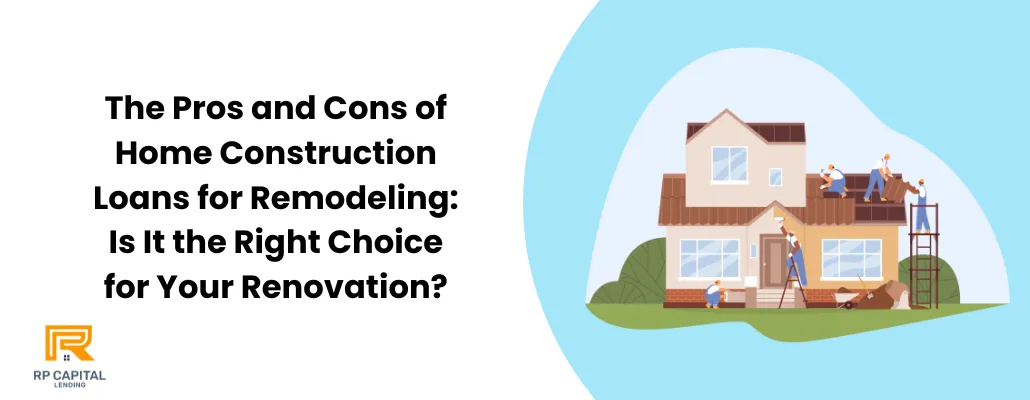Blog

The Pros and Cons of Home Construction Loans for Remodeling: Is It the Right Choice for Your Renovation?
Remodeling a home is an exciting project, whether you're upgrading the kitchen, adding a new room, or making your home more energy-efficient. One of the most popular ways to fund these renovations is by taking out a construction loan.
But is a construction loan the right choice for your remodeling project? In this blog, we'll explore the pros and cons of using a construction loan for remodel, focusing on the important aspects you need to consider before making a decision. Let’s dive in!
What Are Home Construction Loans for Remodeling?

Before we discuss the advantages and disadvantages, it's important to understand what home construction loans for remodeling are. These loans are specifically designed to cover the costs of remodeling or constructing new structures on an existing property. The loan provides funds in stages, based on the completion of specific milestones during the construction process.
Pros of Using a Construction Loan for Remodeling

1. Flexible Funding Options
One of the biggest advantages of a construction loan is its flexibility. These loans are structured to cover a wide variety of home improvement projects, from kitchen renovations to adding extra floors or rooms. Whether your project is big or small, a construction loan can be tailored to meet your specific needs.
2. Interest-Only Payments During Construction
With a construction loan, you typically only pay interest on the amount you've drawn down for the project during the construction phase. This can significantly reduce your financial burden while the work is being completed, allowing you to manage other household expenses.
3. Customization of Your Living Space
A remodel gives you the opportunity to customize your home to fit your exact needs. Whether you're expanding your home to accommodate a growing family or upgrading your kitchen, using a construction loan can provide you with the funds to make those personalized improvements.
4. Increased Home Value
In many cases, a well-planned remodel can increase the market value of your home. For example, adding a new bathroom or renovating your kitchen could yield a higher return when you eventually sell the property. A graph comparing remodel cost vs home value increase can show how specific renovations can boost resale value.
Source: Remodeling Cost vs. Value 2023 Report
According to Remodeling Magazine’s Cost vs. Value Report, homeowners can recoup about 60-80% of their renovation investment when they sell, depending on the project.
5. Loan Flexibility Post-Completion
After construction is complete, you can convert the loan into a traditional mortgage. This flexibility is useful because it eliminates the need to apply for a separate mortgage after the remodel, saving you time and paperwork.
Cons of Using a Construction Loan for Remodeling

1. Strict Qualification Requirements
Qualifying for a construction loan can be more difficult than getting a traditional mortgage. Lenders typically require a higher credit score, and you’ll need to provide detailed plans and cost estimates from contractors. Some homeowners may find this process time-consuming and complicated.
2. Higher Interest Rates
Construction loans often have higher interest rates compared to traditional mortgages. While this might not be a huge problem if your project is short-term, it can add to the overall cost of borrowing if your remodel is extensive and takes longer than expected.
3. Complex Process
Managing a construction loan can be complex. You'll need to coordinate with contractors, submit detailed documentation, and ensure that milestones are met to release funds. The process requires careful management, and unexpected delays or cost overruns could lead to financial strain.
4. Risk of Over-Improvement
There’s always a risk of “over-improving” your home, meaning the cost of your remodel might exceed the increase in property value. If you spend too much on a remodel that doesn't align with the neighborhood’s property values, you may not recover your investment when selling the home.
5. Variable Loan Amounts
Since construction loans are disbursed in stages, based on project milestones, any delays in your project could also delay funding. This can be a problem if you need additional funds to keep the project moving forward.
Is a Construction Loan the Right Choice for Your Remodel?
Here are a few factors to consider before applying for a home construction loan for remodeling:
Your Financial Situation: Assess whether you have the credit score and income stability required to qualify.
Project Scope: Will the remodel significantly increase the value of your home, or is it primarily for personal enjoyment?
Timeline: How long will the renovation take? Delays can add to the cost.
Contractor: Make sure you’re working with a reliable contractor who can provide accurate cost estimates and stay on schedule.
Construction Loan vs. Home Equity Loan: Which Is Better?
If you’re still undecided, consider the alternative of a home equity loan. A home equity loan allows you to borrow against the equity you’ve built up in your home. It may be a simpler option, particularly if your remodel is relatively small in scope.
Here’s a quick comparison:
1. Funding Flexibility:
Construction Loan: Funds disbursed as project progresses.
Home Equity Loan: Full amount disbursed upfront.
2. Interest Rates:
Construction Loan: Typically higher.
Home Equity Loan: Lower, based on home equity.
3. Approval Difficulty:
Construction Loan: Harder to qualify.
Home Equity Loan: Easier to qualify with home equity.
4. Purpose:
Construction Loan: Ideal for large projects.
Home Equity Loan: Best for smaller renovations.
Final Thoughts: Weighing the Pros and Cons
Using a construction loan for remodeling can be a great option if you're planning a large-scale project and need a flexible funding solution. However, it's essential to consider both the benefits and drawbacks before diving in. Make sure to weigh the costs, the complexity of managing the loan, and how the remodel will affect your home’s value.
If you’re ready to remodel but unsure about which loan is right for you, talk to a financial advisor or lender who specializes in home construction loans for remodeling. They can help guide you through the process and find the best option for your needs.
Key Takeaways:
Construction loans offer flexibility and interest-only payments during remodeling.
Increased home value is a potential benefit, but over-improving could result in financial loss.
The qualification process can be complex, and higher interest rates may add to overall costs.
Ready to start your home remodel? Make sure you're fully informed about your loan options before breaking ground!
FAQs
1. Can I use a construction loan for small remodeling projects?
Yes, but a home equity loan may be a better option for smaller projects.
2. Are construction loans risky?
They can be if the project faces delays or goes over budget. Always have a contingency plan.
3. What credit score do I need for a construction loan?
Most lenders require a credit score of 620 or higher.
4. Can I refinance my construction loan?
Yes, many construction loans can be converted into traditional mortgages after the remodel is complete.
5. What happens if my remodel costs more than expected?
You’ll need to either cover the extra costs out-of-pocket or apply for additional funding, which could be expensive.
Disclaimer: Loans only apply to non-owner occupied properties. Rates, terms and conditions offered only to qualified borrowers, may vary upon loan product, deal structure, other applicable considerations, and are subject to change at any time without notice.
Copyright © 2025. All Rights Reserved.


